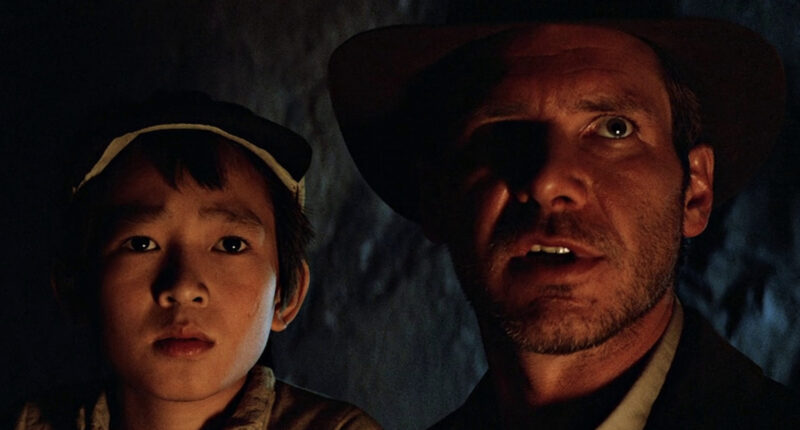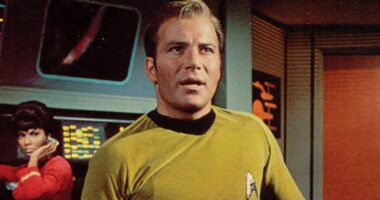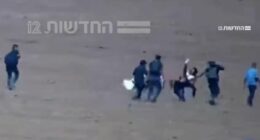Share this @internewscast.com
Few adventure heroes can match the allure of Harrison Ford’s Indiana Jones. Whether you have a soft spot for the classic “Raiders of the Lost Ark” or eagerly await each film’s release, the Indiana Jones series offers something for everyone with its thrilling, swashbuckling tales. Drawing inspiration from the film serials George Lucas and Steven Spielberg enjoyed in their youth, Indiana Jones remains a captivating figure to both old and new audiences. However, with five films in the franchise, one might wonder about the ideal viewing order. Surprisingly, the solution isn’t hidden in a museum.
The Indiana Jones journey began in 1981 with “Raiders of the Lost Ark,” swiftly becoming a worldwide sensation. A few years later, it spawned a sequel, followed by another shortly after. The original trilogy was then left dormant for almost two decades until Indiana returned to cinemas, with another sequel following 15 years down the road. It’s surprising that such a cherished character faced challenges in returning to the big screen, but such is the nature of cinema. When it comes to these five live-action films, the best way to watch them is in the order they were released. Here’s the sequence that captured audiences’ hearts:
- “Raiders of the Lost Ark” (1981)
- “Indiana Jones and the Temple of Doom” (1984)
- “Indiana Jones and the Last Crusade” (1989)
- “Indiana Jones and the Kingdom of the Crystal Skull” (2008)
- “Indiana Jones and the Dial of Destiny” (2023)
With this order in mind, let’s dive into why the release order is the correct way to watch the Indiana Jones movies.
Why is this the correct order to watch the Indiana Jones movies?
Viewing the Indiana Jones films in their release order is essential because that’s how creators George Lucas and Steven Spielberg envisioned it. “Raiders of the Lost Ark” serves as a stellar introduction, laying the groundwork for the franchise. It not only establishes the necessary backstory but also introduces key supporting characters, all while presenting our hero through an unforgettable opening sequence.
Even though “Indiana Jones and the Temple of Doom” technically takes place a year before the events of “Raiders,” it would be an odd movie to start with since it assumes you already know who Indy is in the first place. “Raiders,” by contrast, doesn’t. Additionally, one could accurately argue that “Raiders of the Lost Ark” is still the pinnacle of the Indiana Jones franchise. Because it’s so directly connected to many of the other installments, and it’s considered one of the greatest adventure films ever made, why not start out with the best?
Of course, the beauty of the first three Indiana Jones films is that one could theoretically watch any of them on their own and not be terribly confused, as each of the original installments is essentially standalone — but that gets a bit more tricky when the two legacy sequels enter the conversation. Still, the release order remains the best way to travel abroad with Indiana Jones, even if certain events occur out of order.
Raiders of the Lost Ark (1981)
The first Indiana Jones film to hit theaters, “Raiders of the Lost Ark” thrust Harrison Ford even further into the spotlight after his role as Han Solo in “Star Wars” made him a star, proving that his Hollywood fame was only beginning. As Jones, Ford played a history professor-turned-adventurer during the tail end of the golden age of archeology. Battling rival museums, thieves, and plenty of Nazis, Indy travels the world in search of the biblical Ark of the Covenant, which has been long lost to time. Aided by his friend Sallah (John Rhys-Davies) and his longtime love interest Marion Ravenwood (Karen Allen), whom Indy is reuniting with after separating years earlier, the adventurer pursues the Ark under threat of death until the whole adventure ends with fire and brimstone.
If you’ve ever wondered what it was like to see “Raiders” back in 1981, the truth is that while the film largely received critical acclaim, some believed that it would ultimately be forgotten. It seems impossible now to believe that a movie as iconic, as memorable, and as universally beloved as “Raiders of the Lost Ark” would be in danger of slipping away the same way the Ark itself did, but hindsight is a wonderful thing.
Of course, the opposite proved true, and Indiana Jones quickly became a cultural phenomenon that remains beloved to this day. Whether you adore the spectacular action sequences (especially on the streets of Cairo), the romance between Indy and Marion, or the thrill of the chase, “Raiders” is a true delight and is certainly the feature you should start with.
Temple of Doom (1984)
While technically a “Raiders” prequel, “Indiana Jones and the Temple of Doom” barely has any connection to the original film at all, save for its leading man. Taking Indy and his new companions — orphaned sidekick Short Round (Ke Huy Quan) and lounge singer Willie Scott (Kate Capshaw) — deep into the Himalayas, the trio stumble into an Indian village that has lost its lingam stone. It turns out, a Thuggee cult is responsible for the theft, hoping to use both the lingam and the Sankara Stones to rule the world through human sacrifice and mind control. Many children have been kidnapped as slaves as well, prompting Indy and his pals to put their own lives on the line to save them. In the end, the heroes make it out alive and return the artifact to its proper home (rather than a museum).
Often considered something of an outlier in the Indiana Jones franchise, “Temple of Doom” is the only installment that doesn’t include some evil political power (be it Nazis or Soviet Communists), nor does it feature Indy’s university home or his colleague, Marcus Brody (Denholm Elliott), from the first film. It truly is a unique adventure that, while exciting in its own way, feels vastly different from the standard exploits of this American hero. More than that, Mola Ram (Amrish Puri) is a far more supernatural antagonist than most of Indy’s opponents, with mystical powers that the adventurer can hardly resist. But why was “Temple of Doom” a prequel? Well, simply put, it’s because Lucas and Spielberg didn’t want to use the same villains for round two.
The Last Crusade (1989)
Returning to what made the first film great (while adding plenty of new material to keep things interesting), “Indiana Jones and the Last Crusade” brings the focus back to Indy’s quest to recover biblical artifacts, this time pulling from the New Testament. After years of watching his father, Henry Jones Sr. (Sean Connery), search relentlessly for the Holy Grail, Indy joins the hunt when Henry is kidnapped by the Nazis. Forced to work together, Indy and his father play the Nazis as they travel the map to find the sacred treasure, but while others succumb to the supernatural powers around them, the Jones men are forced to overcome their personal differences and do the right thing. It’s a fantastic film and a solid follow-up to “Raiders,” for sure.
The final installment in the original Indiana Jones trilogy, “The Last Crusade” remains a fan favorite for a reason. Not only is the chemistry between Harrison Ford and Sean Connery perfect for this sort of adventure tale, but the story itself was a major step up from the prequel interlude that was “Temple of Doom.” Taking place only two years after “Raiders” in movie time, the third installment is chock-full of action, suspense, and family drama that is as timeless as the Holy Grail itself. While perhaps not as tight a feature as “Raiders,” it’s a knockout from start to finish, and, as a bonus, the film opens with a stunning look at Indy’s childhood, where young Henry Jones Jr. is played by the late River Phoenix.
Kingdom of the Crystal Skull (2008)
After keeping fans waiting nearly 20 years for a new Indiana Jones adventure, George Lucas and Steven Spielberg finally delivered with “Indiana Jones and the Kingdom of the Crystal Skull.” Taking place in 1957, the film has Indy come out of adventuring retirement (though he remains a history professor) when a young greaser named Mutt Williams (Shia LaBeouf) — who we later learn is his and Marion’s son, Henry Jones III — asks him to help save his friend Harold “Ox” Oxley (John Hurt) from the Soviets. Learning that Ox had found the famed crystal skull in Peru is enough to catch Indy’s interest. Together, Indy, Mutt, and Marion locate the skull and find the chamber where it was originally stolen from. It’s there that the movie goes a bit off the rails, but that’s a discussion for another day.
The first of the two Indy legacy sequels, “Kingdom of the Crystal Skull” was Spielberg’s final work on the franchise as a director and Lucas’ in breaking the story. In many ways, it was truly the end of an era. Even though the film did quite well at the box office, there was no sudden rush for a sequel, so many fans thought that this would be the final adventure for Indiana Jones. It’s no wonder, then, that the fourth installment was quite controversial in its day, with a new character, Mutt, who was divisive at best and a major plot twist that went a bit too far. But whether you love or hate “Kingdom of the Crystal Skull,” it contained some nice moments for longtime fans of the franchise and solidified the importance of “Raiders” to Indy’s larger story.
The Dial of Destiny (2023)
The fifth and final installment in the franchise, “Indiana Jones and the Dial of Destiny” takes place in 1969, 12 years after “Kingdom of the Crystal Skull” (and released 15 years later), with Indiana Jones now set on retiring. His son, Mutt, died off-screen during the Vietnam War, which resulted in his separation from Marion. But when Indy’s goddaughter, Helena Shaw (Phoebe Waller-Bridge), arrives in New York City to claim an old artifact that our hero and her father once stole from the Nazis, all hell breaks loose. Indy and Helena are soon pursued by former Nazi (and current NASA scientist) Jürgen Voller (Mads Mikkelsen), who wants the Archimedes Dial for himself so he can change the outcome of World War II. After experiencing a time warp himself, “Dial of Destiny” ends with Indy reconciling with Marion. They may have a lot of work to do, but he’s now willing to fight for their future.
The only Indiana Jones film not to be helmed by Lucas and Spielberg (though they remained involved as producers), “Dial of Destiny” was directed by James Mangold instead. The film itself briefly returns to Indy’s prime (which de-ages the hero in a flashback sequence) and then expands on the ideas first explored in the previous film, with Harrison Ford offering a solid final performance as the character. The second legacy sequel received largely mixed-to-positive reviews, and while not everyone was terribly thrilled with Indy’s on-screen send-off, it’s a sober reminder that not every story can continue forever. Considering how long it took to get the final two sequels made, we’re lucky we got them at all.
Is there another way to watch the Indiana Jones movies?
If you’ve already seen the Indiana Jones movies all the way through and are looking to revisit the franchise in chronological order, that could certainly be a fun way to enjoy the story. Of course, the easiest way to do this is to simply swap “Raiders of the Lost Ark” for “Temple of Doom.” But there’s another way you could go about this. Consider starting your chronological viewing with the opening sequence from “The Last Crusade,” which takes place in 1912 with a teenage Indy as he’s pursued by a band of graverobbers in Moab, Utah. Not only does this scene establish Indy’s long-standing tenacity, but it also shows us how he got his trademark fedora.
From there, embrace the greater Indiana Jones timeline by watching “Temple of Doom,” set in 1935, and then “Raiders of the Lost Ark,” which takes place in 1936. Then, continue to “The Last Crusade” with all of that compounded history. But here’s where things get a little tricky. If you want to enjoy Indy’s adventures in strict chronological order, watch the opening sequence of “Dial of Destiny” next. Set in 1945, it shows Indy battling the Nazis once more and adds further context to his final two adventures. Then, continue with “Kingdom of the Crystal Skull,” followed by the rest of “Dial of Destiny.” The enhanced chronological order is as follows:
- Opening of “Indiana Jones and the Last Crusade” (1989)
- “Indiana Jones and the Temple of Doom” (1984)
- “Raiders of the Lost Ark” (1981)
- “Indiana Jones and the Last Crusade” (1989)
- Opening of “Indiana Jones and the Dial of Destiny” (2023)
- “Indiana Jones and the Kingdom of the Crystal Skull” (2008)
- “Indiana Jones and the Dial of Destiny” (2023)
Where does Young Indiana Jones fit in?
Of course, any self-respecting Indiana Jones fan is probably wondering where “The Young Indiana Jones Chronicles” (sometimes referred to as “The Adventures of Young Indiana Jones”) falls into all this. Created by George Lucas, the series followed Indy in two distinct periods of his life: his adolescent years and his late teen to early adult years. Played by Corey Carrier in the younger years and Sean Patrick Flanery as he got older, the 28-episode series (which was followed by four TV movies) was largely narrated by an old Indy in the 1990s, played by George Hall. Well, except for one two-part episode (packaged as “Young Indiana Jones and the Mystery of the Blues”) where Harrison Ford returned as a 50-year-old Indy prior to the events of “Kingdom of the Crystal Skull.”
For the most part, one can enjoy “The Young Indiana Jones Chronicles” before watching “Raiders” or apart from the films entirely. Because each installment is set at a different point in Indiana Jones’ complicated backstory, if you want to watch them in chronological order, you may have to do some extra legwork to make it happen. But, then again, Indiana Jones was never a franchise where sticking strictly to the chronology mattered all too much. Instead, enjoy “Young Indiana Jones” however you want to, or ignore it entirely. There’s some debate as to whether the television series is still canon anyway after the events of “Dial of Destiny,” but that doesn’t mean you can’t still be thrilled by young Indy’s adventures.








